Best Tactics Using the Best Forcible Entry Tools
Training Notebook ❘ By LOU COMENALE
Forcible entry props are fantastic training tools. From the brand-new firefighter to the 20-year veteran, everyone can keep up on their forcible entry skills. These props can be built with some firehouse ingenuity or bought from a variety of reputable fabricators. They can be stand-alone or fixed to an existing door. Some forcible entry props are very basic, with only one “locking” mechanism, while others can have multiple locking mechanisms at different points of the door. (For the purposes of this article, locking mechanisms will be considered either a wood dowel, a PVC pipe, or pliable metal.)
If used properly, forcible entry props can engrain muscle memory of the six basic steps of conventional forcible entry: Try, Shock, Gap, Force, Clear, and Control. There seems to be a growing trend with many training props, and that is using tricks or misconceptions to defeat the prop instead of sound techniques.
Inward-Swinging Doors
When we teach forcible entry at my truck company or at the fire academy, we state that every door you come across can and will be forced if you stick to the six steps. The door might be forced early in the process, or a firefighter might have to go through the first four steps and then repeat the first two to force the door. For example, a firefighter who approaches a door that needs to be forced checks to see if the door is locked. If so, he shocks the door at the top, middle, and lower portions.
The shock does a few things for the firefighter. First, it sizes up the door: Where the door does or doesn’t flex will indicate the location of the locking mechanisms. On forcible entry props, this is difficult to simulate because of the prop’s construction. Instructors must emphasize this point and not let students or members skip this step.
Second, and depending on what locks are securing the door, shocking the door might force it open, and your mission will be complete. Always use caution when shocking doors. Lightweight doors or panels could suddenly break apart and you could lose the integrity of the door, which won’t allow you to isolate the fire or eliminate the flow path.
Chances are, the door will not be forced from the shock, and the next step would be to “gap” the door using the adz end of the halligan, which produces the maximum amount of force with a roughly 15:1 mechanical advantage. The gap is created by driving the adz end between the door and the doorstop until the end of the adz contacts the door jamb. Once the adz is driven to the jamb, the firefighter presses either upward or downward on the halligan bar, depending on where the pike is oriented. The orientation of the tool in reference to the pike needs to be understood to get the full rotation and force with the halligan. If the tool is incorrectly rotated, pike into the door, the pike will impede the rotation and make the tool less effective. If a full gap is obtained, the firefighter will have created a two-inch gap between the door and the doorstop. On a real door, the gap can react differently when compared with a forcible entry prop made of metal. A wood-frame door could provide a gap but, more than likely, will end up breaking or cracking the wood stop.
As a company officer and instructor working on forcible entry simulators, I have witnessed “forcible entry hubris,” where the firefighter thinks he must obtain a full two-inch gap every time. This is when tunnel vision sets in and fixation on “getting the gap.” After the third attempt, I instructed the firefighter to move on to capture progress and set the forks; this is where you teach the first “prop trick” (photo 1): The adz end is placed vertically between the door and stop, and the halligan bar is then forced up or down with respect to the way the adz is oriented. This trick works well on doors set into a metal frame but not on residential wood-frame doors. If the gap step hasn’t broken or blown out the wood stop, this trick will. Even on metal frame doors, doorstops are generally between 3⁄8 and ½ inch thick, and the adz in both the gap step and this trick tend to slip out. If the firefighter isn’t cautious, it can cause him injury.
Another forcible entry prop hack happens after the gap step. If a firefighter does not get the full two-inch gap with the adz end, there are instructors who recommend putting the adz back in between the door and the stop and trying to force the door (photo 2). This rarely works on a forcible entry prop and does not work on a metal door in a metal frame when you are on a call. The prying motion puts a rotational force on the tip of the adz, which will inevitably slip out. On a door set into a wood frame, if the doorstop isn’t already busted out, this maneuver will do it.

(1) Photos by author.

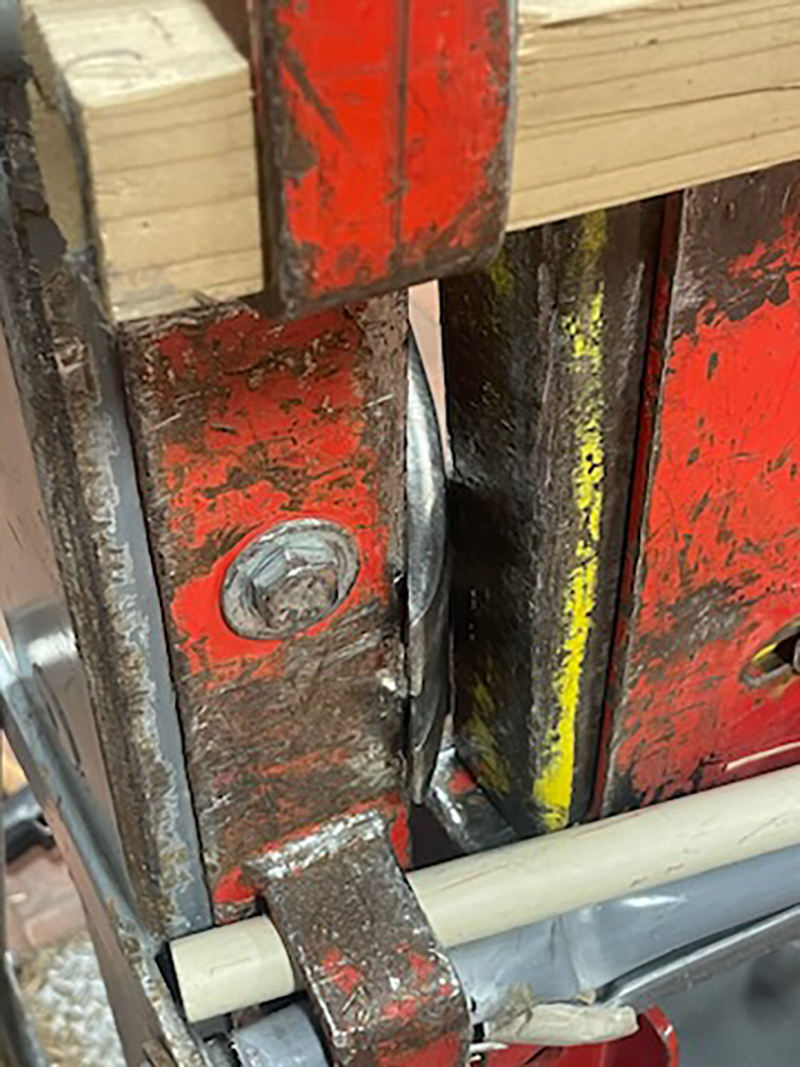
After obtaining the gap, a good practice is to capture the progress with either an ax or a metal or wood wedge. On tight doors, where little to no gap is obtained, the orientation of the forks might have to change from bevel to door to bevel to jam; this allows the forks to work around the door. However, this also comes with a tradeoff. When setting the forks of the halligan bar with the bevel to the jam, the forks will have to be set deeper than if set bevel to the door because, when setting the bevel to the door, the forks will self-lock onto the jam (photo 3). When we set the forks bevel to the door, the forks work their way in easier but will also tend to slip out when forcing (photo 4). However, another advantage of using the tool in this manner is that it lessens the chances of the fork penetrating the thin steel door frame and burying it into the wood frame or block work behind it. Know that although the forks will need to be driven farther in to combat the forks slipping out, this will reduce mechanical advantage.
At this stage of the force, firefighters tend to remove the halligan bar from the door before capturing progress. First, always teach to capture progress. The best way to establish muscle memory is to train and make corrective actions. The other reason firefighters develop poor skills is that wood continues to be the “locking mechanism” for our props. I encourage using different materials to force (photo 5). We have found at our truck company that a combination of materials is the best way to create the “feel” of a real door. Some materials we use in combination are wood, ¾-inch PVC pipe; 1⁄8-inch-wide × two-inch-thick aluminum strips; and unpolished 3⁄4-inch square steel tube. The wood provides the best initial resistance, but the PVC, aluminum, or steel tube provided the best feedback and forced the firefighter to capture progress.
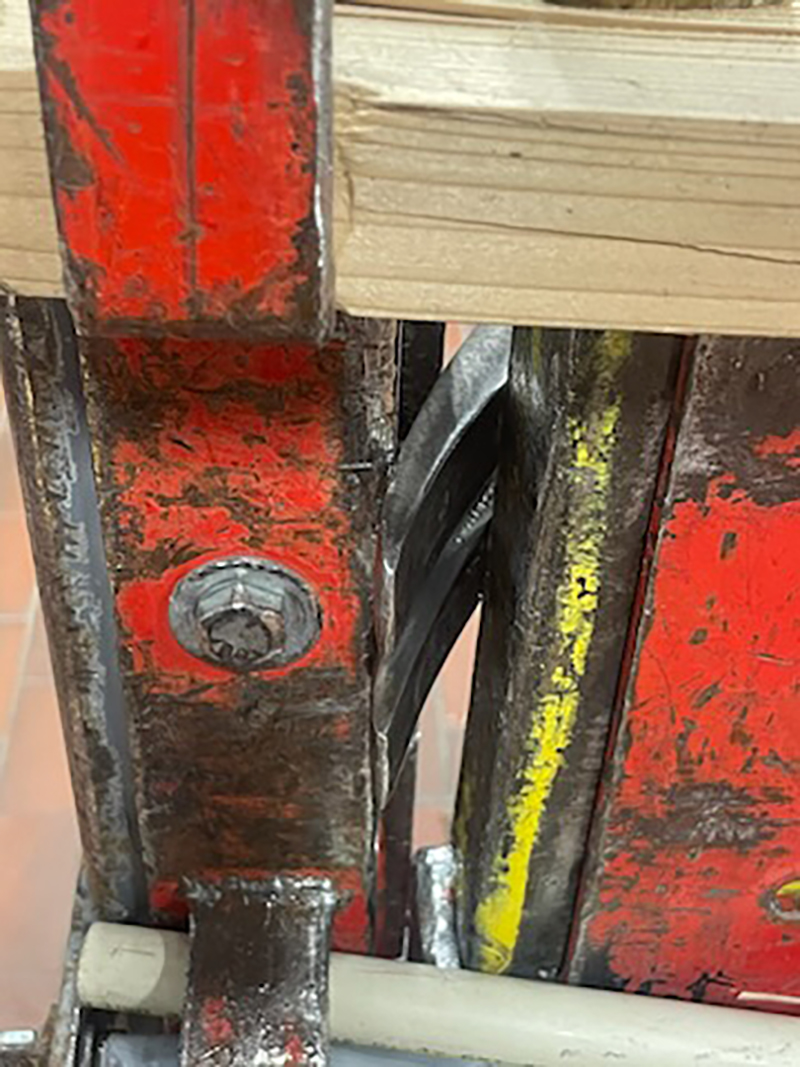
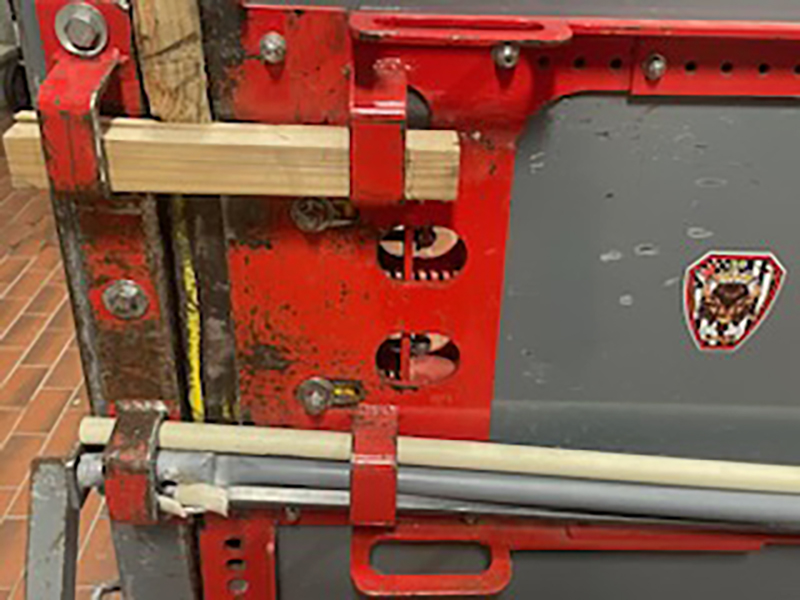
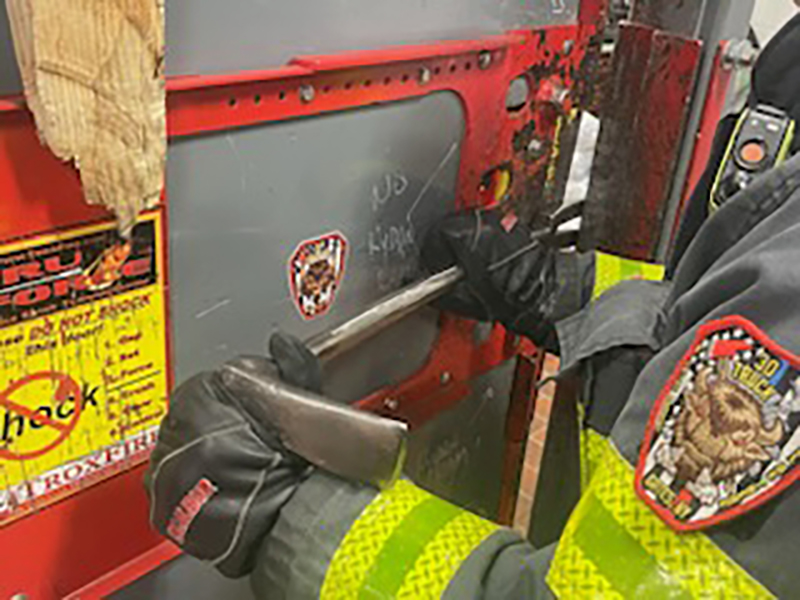
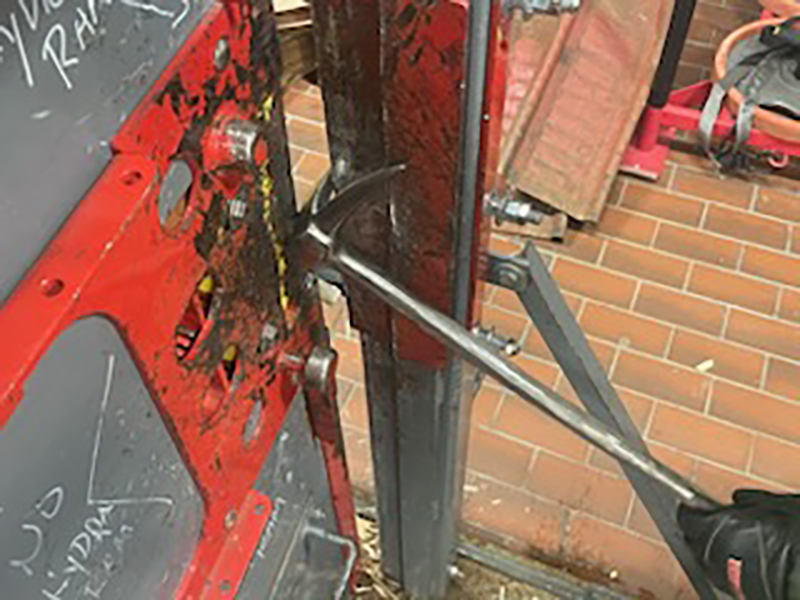

When forcing a door with the forks, the goal is for the halligan bar to use its full range of motion. This occurs when the halligan is maneuvered all the way until it is parallel and contacting the door (photo 6). If the halligan is set bevel to the jam, this cannot be achieved because the adz end prohibits full movement. When the halligan is used bevel to the door, the adz end will allow for a full range of motion, but firefighters and instructors often get fixated on obtaining the full force of the halligan. This can lead to bad techniques. Firefighters tend to “bounce” the tool, which can and will work itself out between the door and door frame. When teaching forcible entry, we instruct to try to keep tension on the halligan, door, and door frame, and when it is time to force it is an explosive motion. This ensures that we do not lose our progress. If the door is tough to force and we do not obtain the full force of the halligan, the firefighter swinging the ax or the firefighter working the halligan has to capture progress with either the ax or wedge.
After the forks are set, and after we have attempted to force the door with the forks and we have captured progress, firefighters tend to use tricks here to finish the force. Our truck company calls this the “clear” step in the steps of forcible entry. When firefighters get to this stage and the door hadn’t been forced open, I have witnessed halligan bars used in a variety of ways. In reality, we don’t need to learn any new motions for our halligan. The firefighter with the halligan bar needs to go back to the gap step of the forcible entry sequence. With the ax or wedge in place to maintain our progress, the adz should be set between the door and the door frame, all the way to the bar (photo 7). Then, depending on the orientation of the halligan, the bar is forced upward or downward. (If the pike is being pushed into the door, it will impede the force.) This creates an additional two inches of spread between the door and door frame. We have now forced four inches of spread (photo 8). If that is not enough, reset the adz and pull the halligan bar toward the door (photo 9).
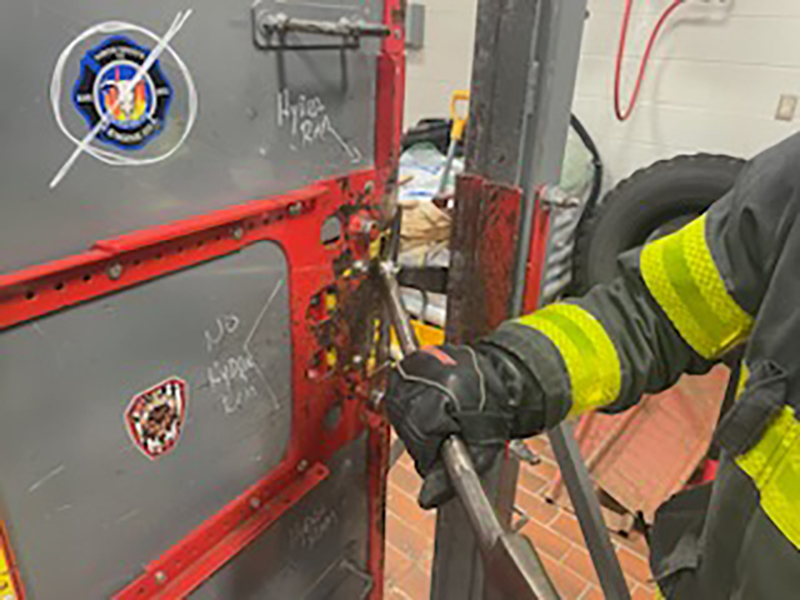
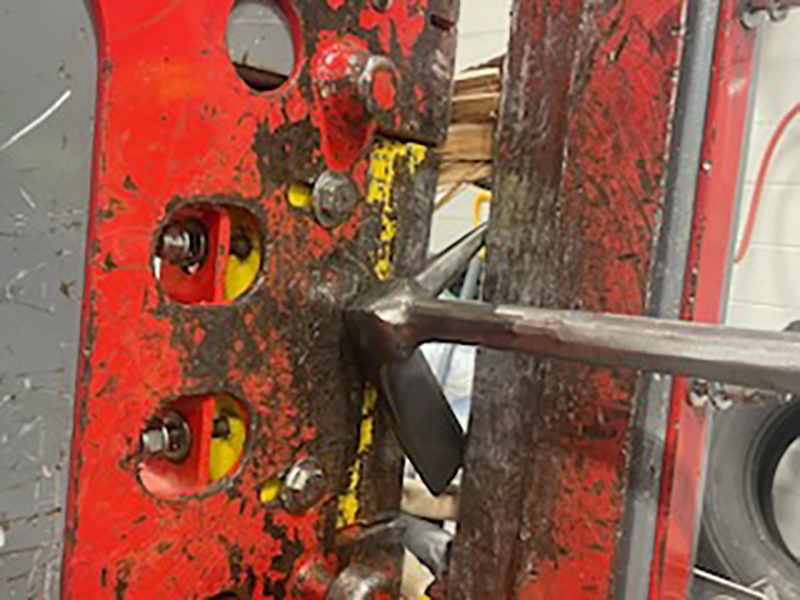
At this point, many firefighters use what I call the “triangle trick” to finish the force. This is where the halligan is oriented so that the adz and pike are in contact with the door frame and the back end of the halligan is in contact with the door (photo 10). This works on wood-frame doors as well. The adz and pike will bite into the wood. On metal frame doors, the halligan has a tendency to slip. When forcing the door with the triangle technique, a slip can lead to injury. The triangle orientation is good to know, but it should not be one of our go-to approaches when forcing doors.
When we use wood for the locking mechanism for door props, we condition or develop muscle memory that doors will react this way. We must remember that not all doors are wood doors in wood frames. When forcing doors in metal frames, we are forcing pieces of metal—the deadbolt or latch—out of a metal receiver. If the metal deadbolt breaks, it simply breaks or pops out of the locking mechanism. Typically, when we force doors, the metal “slips” out of the receiver. Wood-frame doors, depending on the construction method, will bust the deadbolt out of the frame, which then reacts like a wood dowel on a door prop.
Sticking to basics will lead to success in forcible entry. Having alternate plans in the back of your mind is good, but tricks should not be your go-to moves. Bad techniques need to be corrected, and hacks that work on props need to be explained to show why they will not work on real doors. Sometimes, the door forces without completing Try, Shock, Gap, Force, Clear, and Control, but you will achieve success when going through those steps.
LOU COMENALE is an 18-year fire service veteran and the captain of the Gates Fire District truck company in Rochester, New York. He is the lead truck company instructor for the Monroe County (NY) Recruit Training Program, where he was also previously its co-lead instructor. Comenale is also a New York State fire instructor and a Monroe County fire instructor.

